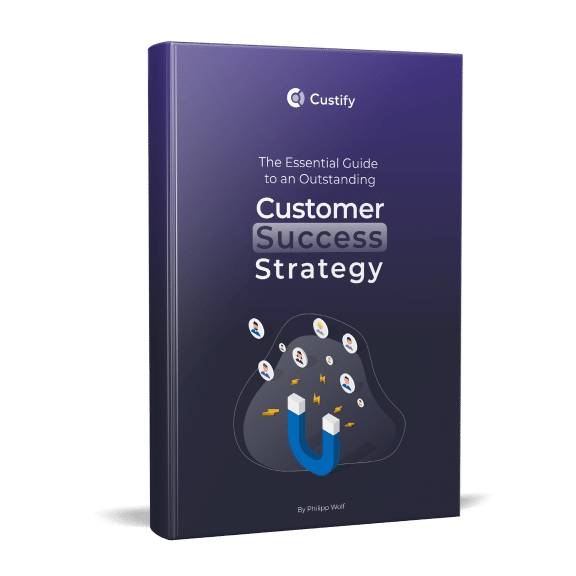You might know the basic ideas behind customer success. But when it comes to actually putting them into practice, things get a bit more complex. Where do you start? What do you focus on? It’s not easy.
So we’ve put together this list of seven proven customer success tactics that will help you grow your business:

1. Personalize All Customer Interactions
In many ways, personalization the cornerstone of customer success.
The first step in personalization is recognizing and understanding each customer’s unique goals. The members of your target market might share similar goals—but if your customer success managers can show to customers that they understand the unique situations and desires of each individual company, you’ll build a base of long-term, high-value customers.
Every interaction your CSM has with a customer should include some discussion of those unique goals. Tailoring your customer success outreach is a good place to start. You should actively reach out to your customers (we’ll talk about this in a moment), and when you do, you should be using an email or phone call that’s unique to that customer.
In our piece on customer success best practices, we talked about adding value in every interaction. That’s a perfect example of personalizing your outreach. If you think a particular customer might benefit from a new feature, have one of your customer success managers call that customer and talk to them about how it will specifically help their business.
Or send them an email congratulating them on an accomplishment that you saw in the news. Fire off a text when you find an interesting article that might be of interest to your customer.
Segmentation can help you here; you wouldn’t want to personalize hundreds or thousands of emails, but you can divide your list into a handful of segments and customize your newsletter to each group.
Segmentation is a hugely powerful marketing strategy, and including it in your customer success strategy can pay big rewards. Just look at MailChimp’s statistics on email segmentation ; email lists segmented by interest have almost 10% more opens, and 74% more clicks. Applying these same principles to your marketing materials can reap similar rewards.
Even when you’re not reaching out to potential customers, you can use personalization to increase the chances that they’ll buy (or engage with your content). Think of Amazon and other online retailers; by tracking what users have looked at and bought, they customize every page with suggestions on what customers might be interested in.
Many retailers use this information for email, social media communications, and advertisements as well.
You might not be able to use all of these methods of personalization. But when you’re thinking about how to best serve your customers, remember that there are many ways that you can speak directly to what they want and need.
2. Proactive Outreach
When customers are having problems with your product or service, they’ll get in touch. But it doesn’t always happen right away. They might try to struggle through an issue on their own. Or they might not know that they’re having an issue (which is why detailed customer success analytics, which we’ll talk about next, are so useful).
That’s exactly why proactive outreach is such a valuable customer success tactic. After you’ve been in business for a while, you’ll have a good idea of the kinds of problems your customers might be running into.
Instead of waiting for them to let you know that they’re struggling, reach out before they have a chance. Ask if they’re having any difficulties. Point out some troubles they might run into and give them advice on how to better use your product.
That’s what proactive outreach is all about: helping people get the most out of your product or service. Traditional customer service waits for customers to reach out and then works on solving a problem. Proactive outreach heads off the problems before they start.
But this outreach isn’t always about problems. It’s about adding value. Your customer success managers should be helping your customers take full advantage of your product. That means getting in touch with helpful resources, new trainings, ideas for expanding their business, and so on.
Customer success can often be a consultative relationship, instead of simply a troubleshooting one. Proactive outreach is central to making that sort of relationship a success.
3. Monitor Performance to Watch for Problems
How do you know when you should be reaching out to your customers? You can do it on a regular schedule, which will put you far ahead of many competitors. You can also use metrics to judge when something isn’t working correctly.
Customer success platforms help you see when people are using your product, how they’re using it, when they’re dropping out of the onboarding process, and more. The data you get from monitoring these customer health scores can be of big help in determining when to reach out.
When performance drops, you can make sure to extend a helping hand before your customer gets annoyed with your product. That keeps the relationship positive, and heads off minor problems before they grow into major ones.
The problems you monitor for will depend on your product, your customer, and your goals. But adoption and usage rates, as well as training results, are a good place to start. When you see a dropoff on any of those metrics, you know it’s time to take action.
4. Simplify All Customer Interactions
Customers want a solution to their problem. Most of them don’t care about the details undergirding how it works. They want to know that it will solve their problem and that it’s easy to use.
This goes back to the marketing maxim of emphasizing benefits, not features. People don’t care that you’re using the latest cloud-based traffic routing technology in your app. They do care that your app is fast, and that they won’t have to wait to download information.
All interactions with your customer, from your advertisements to your customer support to your upselling, should be framed around simple benefits.
You can also simplify the onboarding and training processes. Do you currently have long webinars, extensive documentation, and esoteric user manuals to help your customers start using your product or service?
Try using a simple checklist or two. Get people up and running as soon as possible, and get into the details later.
Simplification should be one of your core customer success tactics. Always be thinking about how you can provide better service by eliminating information or activities that are getting between your customer and what they want.
5. Make Onboarding Easy
Onboarding is often the first part of the customer lifecycle that your customer success team will be involved in. Whether it is or not, it’s certainly a crucial step in setting the right tone of your customer success relationship.
It’s also important for your product: if you can’t get people onboard quickly and smoothly, your adoption rates are going to be low, and that’s not good for anyone.
And while we encouraged you to simplify as many things as you can, you may want to place a special emphasis on onboarding. Make sure that setup and training are especially easy and that customers see the benefits of your product or service immediately.
Some companies offer one-on-one onboarding trainings, which takes pressure off the end user. If you can’t do this at scale, figure out how to provide just enough information for users to get started, and the best way to deliver that information.
It’s easy to go overboard when you’re bringing on new customers—but remember that they just want to know how to use your product and how it will help them. If you can focus on that, you’ll be well on your way to helping your customers succeed.
And, of course, you’ll want to personalize that onboarding where you can.
(Seeing a pattern here? All of these customer success tactics are interconnected.)
6. Publish Lots of (Useful) Content
This is a tactic that you don’t always see in discussions of customer success tactics. And in some ways, it’s only peripheral to the core of the field. But a customer success mindset can help boost the effectiveness of your content publishing.
Let’s think about marketing. A customer success mindset in marketing shows your customers that you understand their problems and how to solve them. If you’re posting blogs and articles about issues that they deal with every day, you’ll establish a relationship and loyalty before they even become customers.
Customer support can also benefit from publishing content with a customer success mindset. Making support materials easily available and immediately useful helps your customers find what they’re looking for quickly (although you should also make it easy to get in touch with your customer success team as well).
Sales should have great content, too; making a first sale or upselling later can be boosted by having the right materials available at the right time.
All of this content works together to show people that your product or service will help solve the problems they face every day. And that’s what’s going to create long-term customer relationships.
7. Get Feedback (And Implement Changes)
Your customers are your most valuable source of information. It’s easy to get caught up in high-tech tools that monitor keyword searches and web metrics, but in the end, your customers will tell you what they need.
Of course, just collecting feedback isn’t a viable customer success tactic. You’ll need to actually implement changes before customer churn becomes a problem. This will be easier for small companies than it will be for large ones, but even big corporations can keep an agile mindset when it comes to customer success.
Putting a system in place for collecting and tracking customer feedback is essential for effective implementation. Not every feature request or question will come through an online form; you’ll also get ideas through your proactive outreach, during trainings, and in offhand conversations.
Make sure that your CSMs know where to record customer requests and suggestions so you can analyze them and take action.
Start Small to Build Something Big
An effective customer success program will help you grow your business. The entire customer lifecycle benefits from a customer success mindset. And when you start making improvements at every step along the way, you’ll see that your customers are getting more out of your product or service.
That’s when customer success really starts to pay off. Because when your customers are getting the most out of your offerings, they’ll develop loyalty, start making referrals, and be open to cross- and upselling.
But it all starts with one small step: committing to customer success. Once you’ve committed, choose a single customer success tactic and start integrating it into your workflows. From there, it’s a simple process of building on what you’ve started until you have a company that’s focused 100% on your customer.
That’s when you know that you’re headed for great things.




